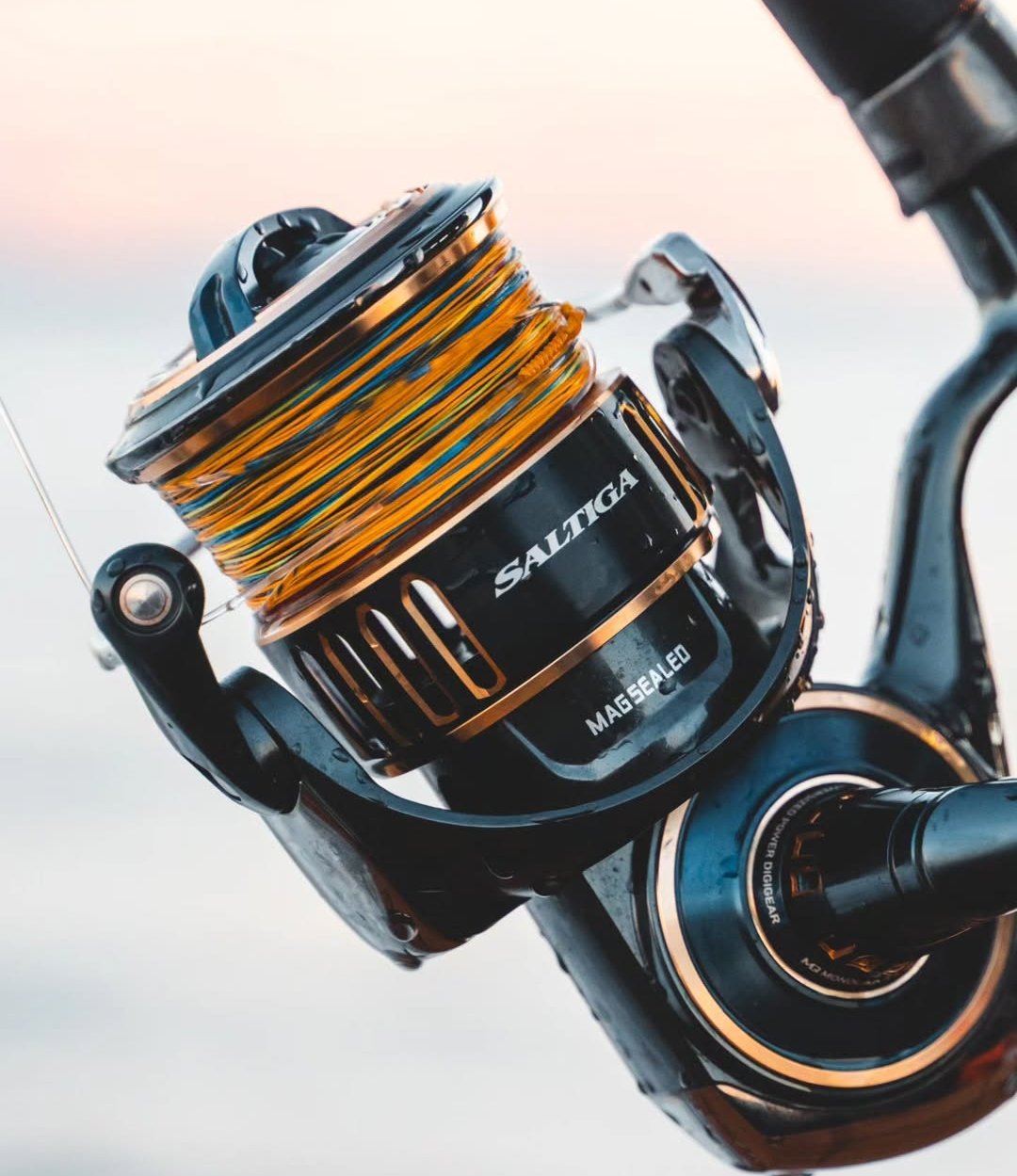
Picture this: You’re loading your kayak onto your vehicle, excited for a perfect day paddling the Buffalo River. But as you arrive at the launch, a game warden approaches and asks to see your boating education certificate. Your heart sinks—you had no idea you needed one. This scenario plays out more often than you’d think across Arkansas’s waterways, leaving kayakers with hefty fines and ruined trips.
I’ve been kayaking Arkansas waters for over a decade, and I’ve seen countless paddlers unknowingly violate state regulations. The truth is, Arkansas has specific requirements that many kayakers—especially those from out of state—don’t know about. Whether you’re a seasoned angler upgrading to a fishing kayak with advanced systems or a weekend warrior exploring our beautiful rivers, understanding these laws isn’t just about avoiding fines—it’s about staying safe and protecting our waterways for future generations.
This comprehensive guide breaks down all what you need to use a kayak in Arkansas legally in 2025, from the Arkansas Game & Fish Commission’s latest regulations to practical gear recommendations that go beyond the bare minimums. We’ll cover registration requirements, safety equipment mandates, and even walk you through the step-by-step process of getting compliant before your next paddling adventure.
🔑 Key Takeaways
- PFD Requirements Are Non-Negotiable: Every person must have a US Coast Guard-approved lifejacket, and children under 13 must wear theirs at all times
- Motorized = Registration: Any kayak with a trolling motor must be registered through the Arkansas Department of Finance
- Age Matters for Education: Anyone born after January 1, 1986, needs boating education certification to operate motorized vessels unsupervised
- Litter Container Law: You must carry a proper litter container if transporting food or beverages—yes, this applies to kayakers too
- Public vs. Private Waters: Know the difference to avoid trespassing charges and respect property rights
Arkansas Kayak Legal Requirements (What the Law Says)
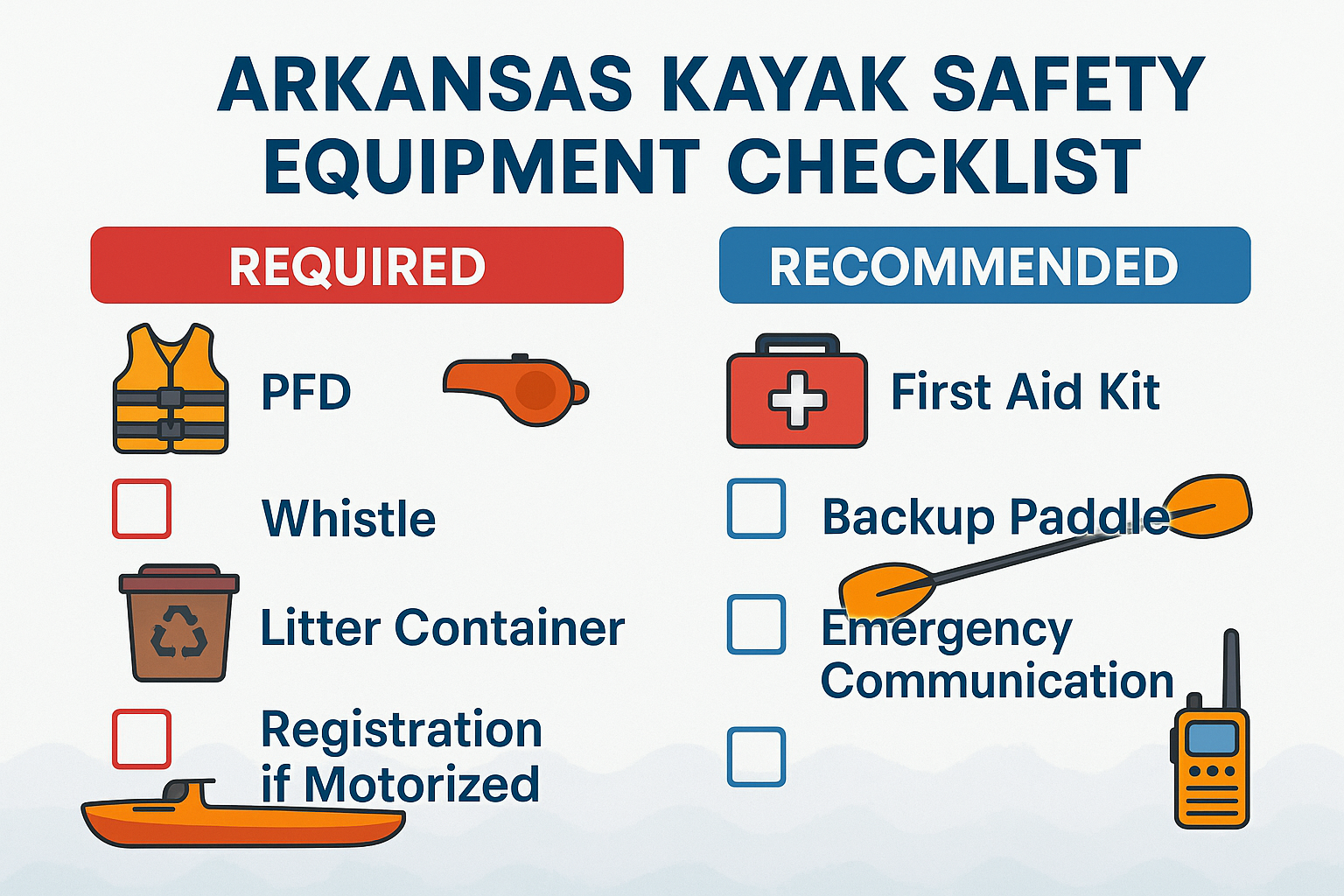
The Arkansas Game & Fish Commission (AGFC) oversees all boating regulations in the state, including those for kayaks. These aren’t suggestions—they’re laws with real penalties for non-compliance. Let me walk you through each requirement so you can paddle with confidence.
Personal Flotation Device (PFD) Requirements
The most fundamental requirement for kayaking in Arkansas is proper life jacket compliance. Here’s what the law mandates:
Every kayak must carry one US Coast Guard-approved wearable PFD for each person aboard. This isn’t optional, even if you’re an Olympic swimmer or paddling in shallow water. The PFD must be:
- In serviceable condition (no rips, tears, or broken buckles)
- Readily accessible (not buried under gear)
- Appropriate size for the intended wearer
- Coast Guard-approved Type I, II, III, or V
Children under 13 have stricter requirements—they must actually wear their PFD at all times while the kayak is underway. Not just have it available, but properly fitted and fastened. I’ve seen parents get citations for having their kids’ PFDs sitting loose in the kayak.
💡 Pro Tip: Inflatable PFDs are legal in Arkansas for anyone 16 and older, but they must be worn to count as your required PFD. If it’s stowed, you need another wearable PFD aboard.
The types of approved PFDs include:
- Type I (Offshore): Best for rough waters but bulky for kayaking
- Type II (Near-shore): Good for calm waters, less bulky
- Type III (Flotation Aid): Most popular for kayaking—comfortable and allows good mobility
- Type V (Special Use): Includes inflatable PFDs when worn
Enforcement is taken seriously. AGFC officers regularly patrol popular waterways, and PFD violations carry fines starting at $50 plus court costs. During holiday weekends and peak season, expect increased enforcement presence.
Registration and Licensing Requirements
This is where many kayakers get confused. The key distinction is motorization:
Non-motorized kayaks (paddle only):
- ✅ No registration required
- ✅ No operator license needed
- ✅ Can launch on any public water
Motorized kayaks (including those with trolling motors):
- ❌ Must be registered with Arkansas Department of Finance
- ❌ Must display registration numbers and decals
- ❌ Operator may need boating education certificate
If you’re upgrading to a kayak fishing setup with a trolling motor, you’ve crossed into “motorboat” territory legally. Even a small electric trolling motor triggers registration requirements.
Boating Education Requirements apply to anyone born after January 1, 1986, who operates any motorized vessel (including kayaks with motors) without supervision. The course covers:
- Navigation rules
- Safety equipment
- Arkansas-specific regulations
- Emergency procedures
- Environmental protection
Age restrictions for unsupervised operation:
- Under 12: Cannot operate any motorized vessel
- Ages 12-15: Can operate if supervised by someone 18+ with valid education certificate
- Age 16+: Can operate independently with education certificate
Special Equipment Requirements
Beyond PFDs, Arkansas has several equipment mandates that catch kayakers off guard:
🗑️ Litter Container Requirement
If you’re carrying food or beverages (yes, even just a water bottle), you must have a container aboard for litter. This often-overlooked law applies to all vessels, including kayaks. A simple mesh bag or small trash container satisfies this requirement.
📢 Sound Signaling Device
Every kayak must carry a sound-producing device. For most paddlers, a simple whistle attached to your PFD meets this requirement. Air horns or other devices work too, but a whistle is practical and always accessible.
💡 Navigation Lights
If operating between sunset and sunrise, you need:
- White light visible 360 degrees (can be handheld)
- Proper navigation lights if motorized
Additional Safety Equipment (not legally required but strongly recommended):
- Bailer or bilge pump
- Paddle leash
- First aid kit
- Emergency signaling devices
Arkansas Kayak Requirements Compliance Checker
Essential Gear Checklist for Arkansas Kayaking
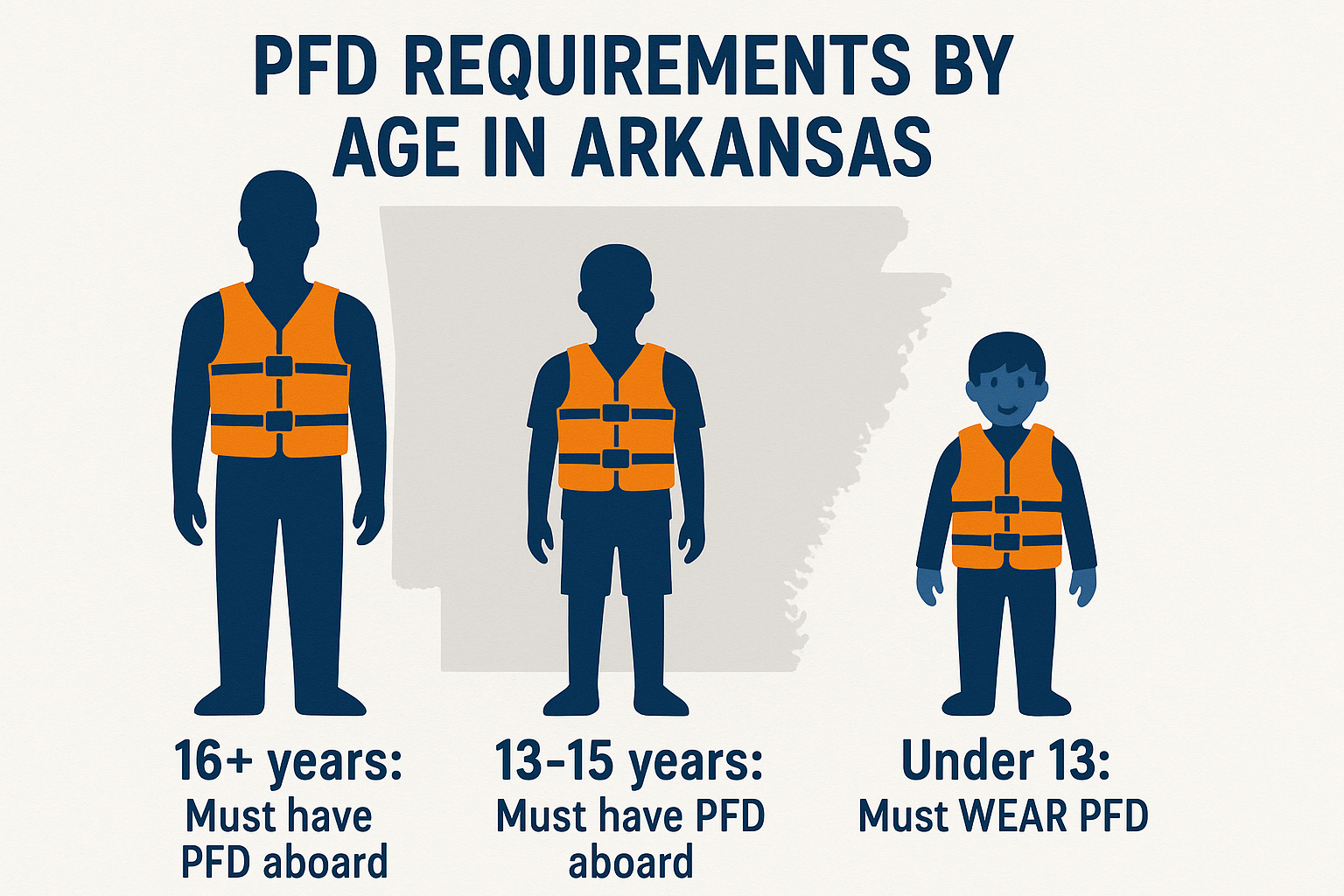
While legal compliance keeps you out of trouble, proper gear keeps you safe and comfortable. Here’s my comprehensive checklist developed over years of paddling Arkansas waters.
Required Safety Equipment
Let’s start with the non-negotiables—gear you must have to paddle legally:
| Equipment | Legal Requirement | My Recommendation |
|---|---|---|
| PFD | One per person | High-back kayak-specific Type III |
| Whistle | Sound device required | Fox 40 attached to PFD |
| Litter Container | If carrying food/drinks | Mesh bag with carabiner |
| Registration | If motorized | Laminated in waterproof holder |
| Lights | If paddling at night | 360° white LED + backup |
Choosing the Right PFD: Not all lifejackets are created equal for kayaking. Look for:
- High-back design that doesn’t interfere with seat
- Multiple adjustment points for secure fit
- Pockets for safety gear
- Bright colors for visibility
- Reflective tape for low-light conditions
I personally use a NRS Chinook, which has served me well on everything from calm lake paddles to technical river fishing trips. The key is finding one comfortable enough that you’ll actually wear it.
Recommended Safety Gear Requirement: What You Need to Use a Kayak in Arkansas
Beyond legal requirements, these items have saved my trips (and possibly my life) multiple times:
🏥 First Aid Kit Essentials:
- Waterproof case
- Bandages and gauze
- Antibiotic ointment
- Pain relievers
- Allergy medication
- Emergency blanket
- Duct tape (seriously, it fixes everything)
📡 Emergency Communication:
- Waterproof phone case
- VHF radio (for larger waters)
- Emergency whistle (beyond your required one)
- Signal mirror
- Flares or signal flag
☀️ Weather Protection:
- Quick-dry clothing layers
- Rain jacket
- Sun hat with retention cord
- Polarized sunglasses with strap
- SPF 50+ sunscreen (reapply often!)
Navigation and Comfort Equipment
Making your paddle enjoyable requires the right supporting gear:
Paddle Selection:
- Primary paddle sized correctly (I use the torso + arm method)
- Backup paddle (learned this lesson the hard way on the Mulberry)
- Paddle leash for hands-free moments
- Drip guards for cold weather
Storage Solutions:
- Dry bags in multiple sizes
- Deck bag for frequently needed items
- Waterproof phone case
- Gear tracks for accessories
Comfort Items:
- Quality seat pad or upgrade
- Hydration system
- Snacks in waterproof container
- Towel
- Change of clothes in dry bag
Arkansas Kayak Registration Process (Step-by-Step)
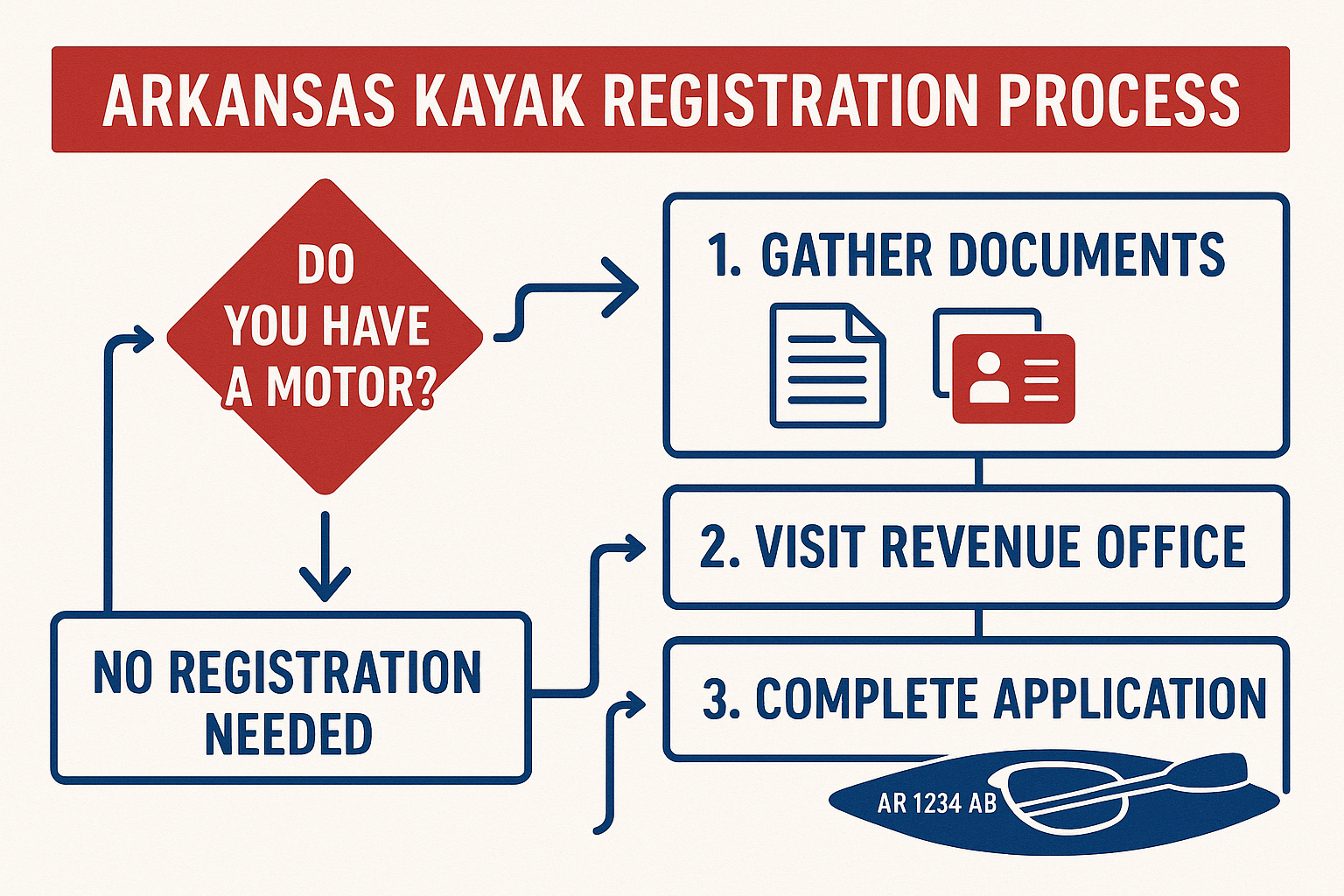
If you’ve added a motor to your kayak, registration isn’t optional—it’s the law. Here’s exactly how to get legal.
When Registration is Required
You must register your kayak if:
- It has any type of motor (gas or electric)
- You use it on public waters
- It’s your primary propulsion method
Registration is NOT required for:
- Paddle-only kayaks
- Private pond/lake use only
- Kayaks under 12 feet used exclusively for racing
The distinction about public waters is crucial. Even with a motor, if you only paddle your private farm pond, registration isn’t required. But the moment you trailer to a public lake or river, you need those numbers displayed.
How to Register Your Kayak
I recently helped a buddy register his new motorized fishing kayak, so this process is fresh in my mind:
Step 1: Gather Required Documents
- Proof of ownership (bill of sale or manufacturer’s statement)
- Driver’s license
- Hull identification number (HIN)
- Payment method
Step 2: Visit Arkansas Department of Finance & Administration
- Local revenue office locations statewide
- Online registration available for renewals only
- Initial registration must be done in person
Step 3: Complete Application
- Form provided at office
- Declare kayak length and motor type
- Pay fees (currently $7 for initial registration + processing)
Step 4: Receive Your Numbers
- Certificate of Number (keep aboard in waterproof holder)
- Registration decals
- Registration numbers to display
Timeline: Same-day service at most offices. Registration valid for 3 years from issue date.
Displaying Registration Properly
This is where people mess up and get citations despite being registered:
Number Placement Requirements:
- Both sides of the bow (forward half)
- Block letters at least 3 inches high
- Contrasting color to hull
- Reading left to right
- Numbers separated from prefix/suffix by space or hyphen
Example: AR 1234 AB
Decal Positioning:
- 3 inches behind registration number
- Same level as numbers
- Both sides of kayak
- Current year visible
⚠️ Common Mistake: Placing numbers too far back or using reflective/fancy lettering. Keep it simple and legal—block letters only.
Arkansas Boating Education Requirements
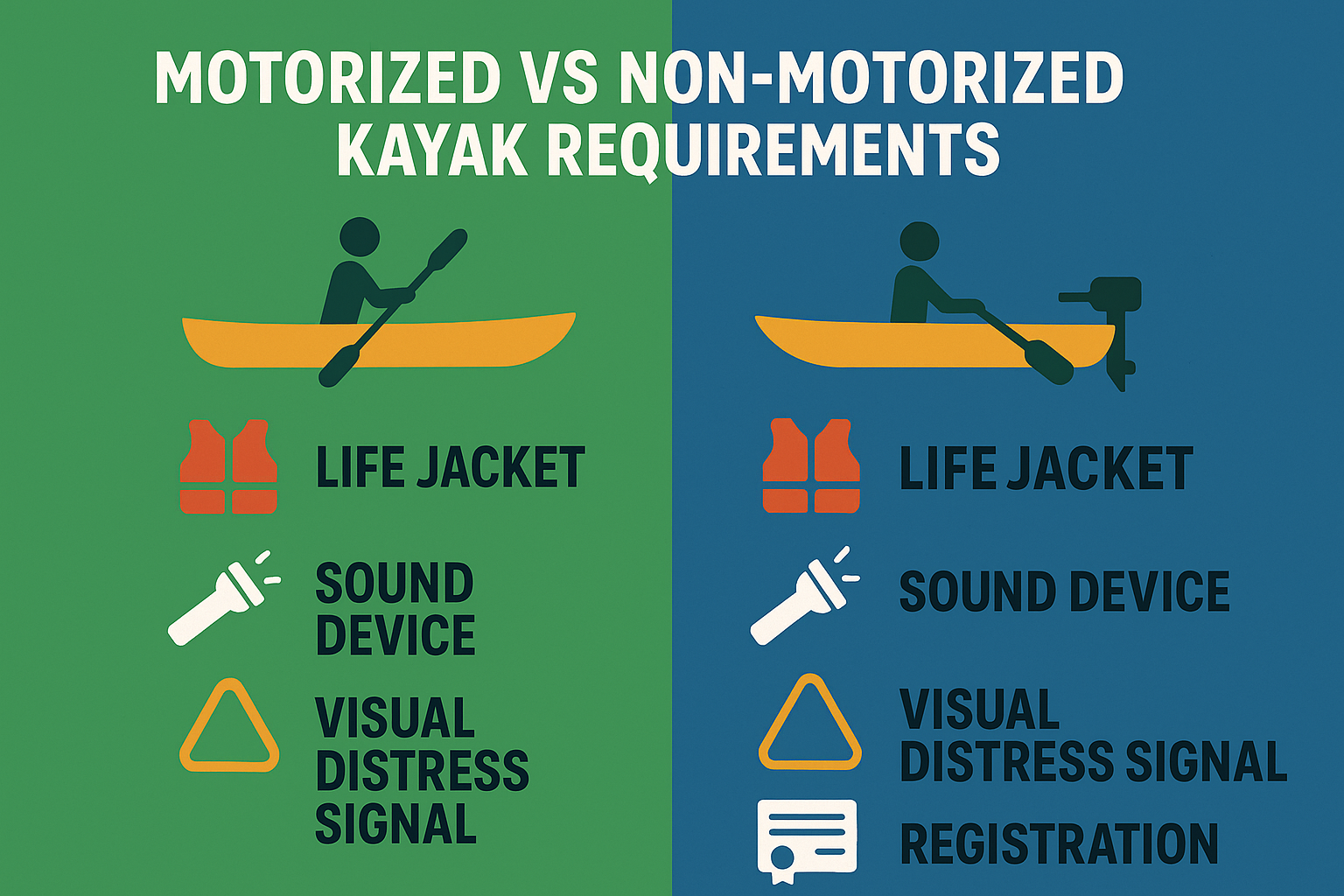
The boating education requirement trips up more kayakers than any other regulation, especially those upgrading to motorized systems.
Who Needs Boating Education
Mandatory Education Required For:
- Anyone born after January 1, 1986
- Operating any motorized vessel
- Including kayaks with trolling motors
- On Arkansas public waters
Exemptions:
- Born before January 1, 1986
- Operating under direct supervision
- Valid NASBLA-approved certificate from another state
- Active military with orders
The “born after” date might seem arbitrary, but it’s Arkansas’s way of phasing in mandatory education. If you’re 38 or younger in 2025, you need certification to run that trolling motor solo.
How to Get Your Boating License
Having just renewed my certification, here’s the current process:
Option 1: Online Course (Most Popular)
- AGFC-approved providers only
- Self-paced learning
- Usually $29.95-$39.95
- Immediate certificate upon passing
- Print at home
Option 2: Classroom Course
- Offered seasonally by AGFC
- Free but limited availability
- 8-hour commitment
- In-person testing
- Certificate mailed
Course Content Covers:
- Arkansas-specific regulations
- Navigation rules
- Safety equipment requirements
- Emergency procedures
- Environmental stewardship
- Accident reporting
Testing Requirements:
- 60 questions
- 80% passing score
- Unlimited retakes
- Open book for online
The online course took me about 3 hours total, including breaks. The content is actually useful—not just regulatory fluff.
Boating Under Supervision
For young anglers or those without certification:
Ages 12-15 Can Operate If:
- Directly supervised
- Supervisor is 18+ with valid certificate
- Supervisor maintains line of sight
- Supervisor can take immediate control
“Competent Adult” Definition:
- 18 years or older
- Valid boating education certificate
- Not impaired
- Actively supervising (not fishing from shore)
Acceptable Scenarios:
- Parent/child in same kayak
- Adult in adjacent kayak within voice range
- Teaching controlled operation
Penalties for Violations:
- Operator: $50-$200 fine
- Supervisor: Similar fines + liability
- Repeat offenses: Increased penalties
Where You Can Legally Kayak in Arkansas
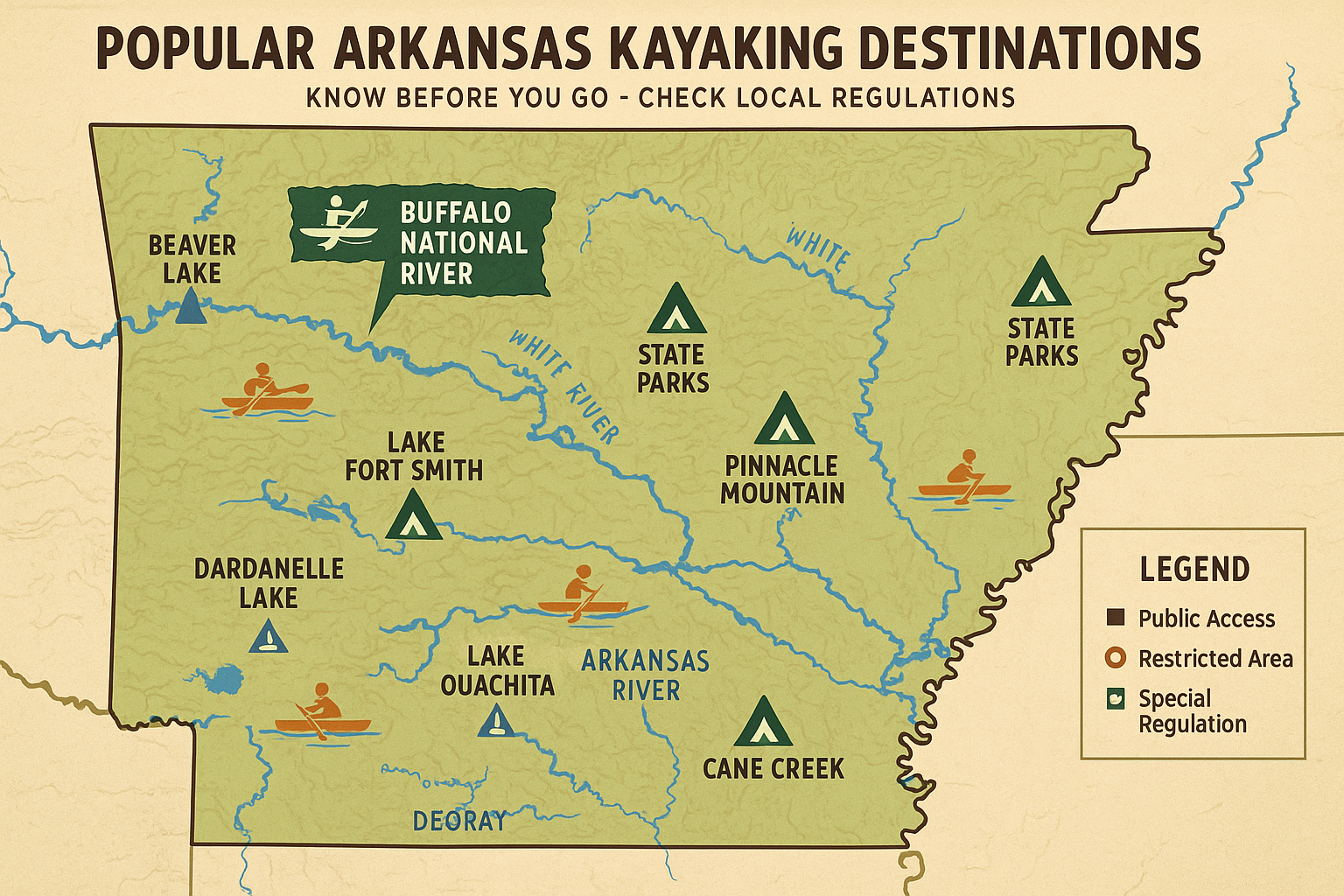
Understanding where you can paddle is just as important as having the right gear. Arkansas offers incredible diversity, but access rights vary significantly.
Public Waters vs. Private Waters
Public Waters Include:
- Navigable rivers and streams
- State and federal lakes
- Municipal reservoirs (check specific rules)
- Waters with public access points
Private Waters Require:
- Landowner permission
- Written preferred
- Respect for property boundaries
- Understanding of liability
The key term is “navigable”—in Arkansas, this generally means floatable year-round by recreational craft. But here’s where it gets tricky: the water might be public, but the land underneath and alongside might not be.
Access Rights on Public Waters:
- ✅ Float through private property
- ✅ Fish from your kayak
- ❌ Cannot touch bottom or banks without permission
- ❌ Cannot cross private land to access
Popular Arkansas Kayaking Destinations
Each destination has unique rules beyond state requirements:
🏞️ Buffalo National River
- America’s first national river
- Federal regulations apply
- No registration required for non-motorized
- Specific camping/fire rules
- Alcohol restrictions in some areas
🏕️ State Parks (Check specific park rules)
- Day use fees often required
- Launch permits at some locations
- Quiet hours for motorized craft
- Seasonal restrictions possible
🌊 Corps of Engineers Lakes
- Federal regulations overlay state rules
- Life jacket requirements may be stricter
- Restricted areas near dams
- No-wake zones marked
🏛️ Municipal Waters
- City-specific ordinances
- Hours of operation
- Permit requirements vary
- Local enforcement
Restricted Areas and Seasonal Closures
⚠️ Always Check Before Launching:
Wildlife Protection Zones:
- Nesting areas (seasonal)
- Endangered species habitat
- Waterfowl rest areas
- Posted with signs
Seasonal Restrictions:
- Spawning closures
- Hunting season conflicts
- High water closures
- Maintenance periods
Dam Safety Zones:
- Strict exclusion areas
- Strong currents and hydraulics
- Sirens indicate water release
- Never approach from downstream
Emergency Closures:
- Flood conditions
- Water quality issues
- Search and rescue operations
- Check AGFC alerts
Arkansas Kayaking Safety Rules and Best Practices
Legal compliance is your baseline—real safety requires going beyond minimums. Arkansas’s diverse waters demand respect and preparation.
Weather and Water Conditions
Arkansas weather can change faster than you can paddle to shore. I’ve experienced perfectly calm mornings turn into dangerous afternoons within hours.
🌩️ Lightning Safety Protocol:
- Check forecast before launching
- Watch for building clouds
- 30-30 rule: Seek shelter if thunder follows lightning by 30 seconds
- Wait 30 minutes after last thunder
- Get OFF the water—you’re the highest point
🌊 Flood and High Water Safety:
- Check USGS water levels before launching
- Understand “strainers” (downed trees)
- Never paddle flood stage
- Scout take-outs at high water
- File a float plan
❄️ Cold Water Considerations:
- Water below 60°F is dangerous
- Dress for immersion, not air temp
- Understand hypothermia timeline
- Carry emergency warming supplies
- Shorten trip distances
Wildlife Safety in Arkansas Waters
Arkansas’s biodiversity makes paddling exciting but requires awareness:
🐊 Alligator Safety (Southern Arkansas):
- Present in some southern waters
- Give wide berth (50+ feet)
- Never feed or approach
- Avoid nesting areas (spring)
- Make noise when launching
🐍 Snake Awareness:
- 6 venomous species in Arkansas
- Most active April-October
- Watch overhanging branches
- Check gear before handling
- Carry snakebite kit
🦟 Insect Protection:
- Mosquitoes and ticks prevalent
- DEET or picaridin essential
- Treat clothing with permethrin
- Check for ticks immediately after
- Consider bug jacket for dawn/dusk
Wildlife Observation Ethics:
- Maintain respectful distance
- No flash photography of nesting birds
- Pack out all trash
- Avoid loud noises
- Never pursue fleeing animals
Group Paddling Requirements
While Arkansas doesn’t mandate specific group protocols, smart practices prevent problems:
Group Size Management:
- Keep groups under 12 for management
- Designate lead and sweep paddlers
- Maintain visual contact
- Establish hand signals
- Regular headcounts
Communication Protocols:
- Pre-trip safety briefing
- Whistle signals agreed upon
- VHF radios for larger groups
- Meeting points established
- Emergency procedures clear
Leave No Trace on Water:
- Pack out everything
- Minimize shoreline impact
- Respect wildlife
- Camp in designated areas
- Dispose of waste properly
Penalties and Enforcement in Arkansas
Understanding enforcement helps you interact professionally with officers and avoid costly mistakes.
Common Violations and Fines
Based on AGFC enforcement data and personal observations, here are the most frequent citations:
| Violation | Fine Range | Additional Consequences |
|---|---|---|
| No PFD | $50-$150 | Court costs, safety course |
| No registration | $50-$250 | Impoundment possible |
| No education certificate | $50-$200 | Mandatory course |
| Littering | $100-$1,000 | Community service |
| Trespassing | $100-$500 | Criminal charges possible |
Aggravating Factors that increase penalties:
- Alcohol involvement
- Refusing inspection
- Repeat offenses
- Accidents resulting
- Environmental damage
Law Enforcement on Arkansas Waters
Who Can Stop You:
- AGFC Wildlife Officers (primary enforcement)
- State Police (state waters)
- Local law enforcement (jurisdiction-specific)
- Federal officers (Buffalo River, Corps lakes)
- Park rangers (state/federal parks)
Inspection Authority:
Officers can stop any vessel to check for:
- Safety equipment compliance
- Registration/documentation
- Operator certification
- Sobriety
- Fish and game violations
Your Rights and Responsibilities:
- ✅ Must stop when signaled
- ✅ Provide requested documents
- ✅ Allow safety inspection
- ✅ Be respectful and cooperative
- ❌ Cannot refuse safety check
- ❌ Don’t argue on water (court is proper venue)
How to Avoid Problems
Pre-Launch Compliance Checklist ✅:
- [ ] PFD for each person (kids wearing theirs)
- [ ] Whistle attached to PFD
- [ ] Litter container aboard
- [ ] Registration current (if motorized)
- [ ] Numbers/decals properly displayed
- [ ] Education certificate in possession
- [ ] Lights working (if applicable)
- [ ] All zippers/buckles functional
Documentation Best Practices:
- Laminate all certificates
- Keep copies in vehicle
- Photo backup on phone
- Know your numbers
- Carry ID always
Professional Interaction Tips:
- Reduce speed when approached
- Keep hands visible
- Answer questions honestly
- Don’t make excuses
- Thank officer (even if cited)
Cost Breakdown: What It Really Costs to Kayak Legally in Arkansas
Arkansas Kayaking Cost Calculator
Calculate your legal compliance costs based on your kayaking setup
🛡️ Essential Legal Requirements
⚡ Motorized Kayak Add-ons
💡 Optional Upgrades
Let’s talk real numbers. Budgeting for legal compliance doesn’t have to break the bank if you plan smart.
One-Time Costs
Essential Legal Compliance:
- Boating Education Course: $30-40
- Quality PFD: $50-150
- Whistle: $5-10
- Litter Container: $5-20
- Total Minimum: ~$90-220
If Adding Motor:
- Initial Registration: $7 + fees (~$30 total)
- Numbers/Letters: $10-25
- Additional Safety Gear: $50-100
- Motorized Addition: ~$90-155
Smart Shopping Tips:
- End-of-season sales (September-October)
- Used PFDs (check condition carefully)
- Group course discounts
- Package deals at retailers
Ongoing Costs
Annual/Recurring Expenses:
- Registration Renewal (every 3 years): ~$30
- PFD Replacement (5-7 years): $50-150
- Safety Gear Updates: $20-50/year
- Course Renewal: Not required currently
Hidden Costs to Consider:
- Gas for registration office trip
- Replacement whistles (they disappear)
- New numbers if kayak color changes
- Dry storage for documents
Money-Saving Tips
🤝 Equipment Sharing (Legal Considerations):
- PFDs cannot be shared during use
- Registration is vessel-specific
- Education certificates are personal
- Safety gear can rotate between trips
💰 Best Value Purchases:
- PFD: Invest in quality—comfort equals compliance
- Education: Online saves time and gas
- Registration: 3-year is best value
- Whistle: Buy multi-packs
Group Discounts Available:
- Boating courses (10+ people)
- Bulk safety gear purchases
- Club memberships for access
- Group insurance policies
Building your own kayak trailer can save hundreds versus buying, letting you invest in better safety gear.
Frequently Asked Questions: Arkansas Kayak Requirements
After years of paddling and talking with fellow kayakers, these questions come up constantly:
Do I need a license to kayak in Arkansas?
For paddle-only kayaks: No license or registration required. However, you must follow all safety equipment requirements (PFD, whistle, litter container).
For motorized kayaks: You need:
- Vessel registration from Department of Finance
- Boating education certificate (if born after 1/1/1986)
- All safety equipment requirements
What happens if I’m caught without a PFD?
First offense typically results in:
- $50-150 fine plus court costs
- Warning for future compliance
- Possible safety course requirement
- Officer discretion on continuing trip
The real cost? Your safety. Arkansas waters claim lives every year—most victims weren’t wearing PFDs.
Can I use an inflatable PFD in Arkansas?
Yes, BUT:
- Must be Coast Guard Type V approved
- Only for persons 16 and older
- Must be worn to count as your required PFD
- Manual and automatic inflation both acceptable
- CO2 cartridge must be properly installed
If your inflatable isn’t being worn, you need another approved PFD aboard.
Do I need registration for a fishing kayak with trolling motor?
Absolutely yes. The moment you attach any motor—gas or electric, regardless of size—your kayak becomes a “motorboat” under Arkansas law. This includes:
- Small trolling motors
- Electric paddle drives
- Gas outboards
- Jet drives
Popular fishing kayaks designed for motors must be registered before hitting public waters.
What if I’m just visiting Arkansas from another state?
Good news for visitors:
- 90-day reciprocity for vessel registration
- Valid out-of-state boating education accepted
- Must follow all Arkansas safety requirements
- Consider getting Arkansas certificate if frequent visitor
Required for all regardless of residency:
- PFD compliance
- Safety equipment
- Age restrictions
- Behavior regulations
Conclusion
Navigating Arkansas’s kayaking regulations doesn’t have to be overwhelming. Yes, there are rules to follow and gear to purchase, but these requirements exist for good reasons—they keep us safe and protect the incredible natural resources we’re privileged to enjoy.
From my experience, the anglers who thrive are those who view compliance not as a burden but as part of being a responsible paddler. That $30 boating course? It might teach you something that saves your life. The PFD requirement? It’s rescued countless paddlers from Arkansas’s unexpectedly swift waters. Even that seemingly silly litter container rule helps keep our waterways pristine for future generations.
Whether you’re upgrading to an advanced motorized fishing kayak setup or keeping it simple with paddle power, staying legal is straightforward:
- Get your safety gear sorted
- Complete education if required
- Register if motorized
- Respect access rights
- Paddle responsibly
Your Next Steps:
- Inventory your current gear against the requirements
- Sign up for boating education if needed (online is fastest)
- Visit FishMasterGuide.com for gear reviews and local spot recommendations
- Plan your next adventure with confidence
Arkansas offers some of the most diverse and beautiful paddling in the country—from the wild Buffalo River to serene mountain lakes to productive fishing waters. Don’t let uncertainty about regulations keep you from experiencing these treasures. Get legal, get safe, and get out there.
Remember: every time you launch legally equipped and properly educated, you’re not just following rules—you’re setting an example and protecting access for all paddlers. See you on the water! 🚣♂️



